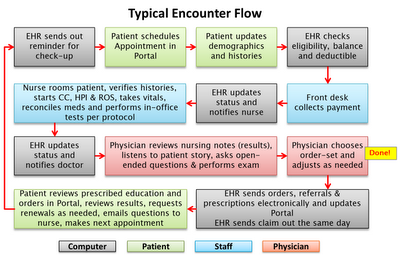If you played any type of contact sports in high school or college, you probably bought yourself a mouth guard at some point. You can take it out of the package and pop it in your mouth, and you may have done that in a pinch, but it works and fits much better if you take it home, soften it in boiling water and mold it to perfectly fit your mouth. An old business adage says that you have to spend money to make money. With EHRs you have to spend time to save time (and maybe make a little bit of money too). You have to spend time softening and molding that EHR to fit your future practice. The biggest mistake people make, is to attempt to push and shove an off-the-shelf EHR into their current practice. This is not much different and makes as much sense as using Microsoft Word on a tablet with a stylus to hand write on it. So how do you go about molding an EHR to fit a future environment that is both enabled and limited by the introduction of the same EHR? Is your EHR a chicken or an egg? And no, I don’t think I want to hear the answer to this one.
 |
| Figure 1: EHR enabled office visit (click picture to enlarge) |
- The EHR is sunk cost. You already paid for it and any additional tasks that can be offloaded to the EHR are net gains to you and your practice.
- You are the only billable resource in the practice. Any tasks that can safely be offloaded away from you can increase billings (or leisure time, or quality of service).
- Patients are a completely free resource. Granted, not all your patients can contribute the same amount of work (i.e. engagement), but whatever is contributed is again a net gain to your practice.
Skeptical? Of course you are. Unfortunately, there are no EHRs that come out of the box with all those efficiencies built in or with simple cookbook instructions on how to get there. So here are a few pointers to get you started.
- Make your own visit templates. Either you tweak the ones included in a good EHR or start from scratch and create exactly what you like. In most cases this is immensely time consuming, but if you don’t spend time upfront to mold your visit templates to your liking, you will never derive maximum utility from the EHR. Remember the paper forms you used before the EHR? Somebody had to make those forms too. EHR templates are more flexible than paper forms and creating your own templates will take more time and expertise. You will have to try them out and adjust as you go. You don’t really need hundreds of templates. A dozen or so, well-chosen ones should make a good start. If your EHR allows you to configure flowsheets, make a bunch of those as well.
- Create order sets and if your EHR allows, add those to pertinent templates. You can start with simple things and work your way up to more complex visits. You shouldn’t need too many here either. You don’t want to have so many templates and order sets that it becomes difficult to find the one you need. Fewer and more general ones work better.
- Configure pick lists and favorites. Everywhere you can, create short lists of frequently used items. This is especially helpful for orders and diagnoses.
- Deploy the patient portal that comes with your EHR and don’t be afraid to open it up for patients to do as much as possible online. Have your staff actively promote the portal to patients and give out instructions on how to use it. It will take time for patients to get used to online interaction with your practice, and it will take time for staff to get accustomed to it too, but savings can be significant depending on who your patients are, of course.
- Make sure that every automated billing feature available from your vendor is turned on and working properly. It won’t hurt to contact the vendor and find out if there’s anything new in this area that you are not aware of, particularly if you had this EHR for a few years. Some of these things will cost you extra, but are well worth the expense.
 |
| Figure 2: Principles of the quest for utility (click on picture to enlarge) |





Thank you for this excellent post. We just posted an article at NY Physician Magazine exploring the Benefits of changing to EMR. It might also be worth a read. http://nyphysicianmagazine.com/
ReplyDeletethanks for this, surely this is a great help
ReplyDeleteRegistered Nurse Salary in Maine
A great help to physicians as well as patients. The workflow of it would be easier for them. Save time and effort and everybody can benefit from it.
ReplyDeleteJoan @ Doctor Websites